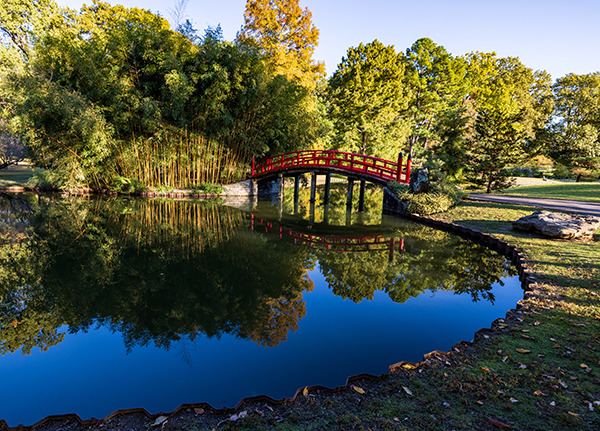After 70 years, it would be reasonable if Memphis Botanic Garden decided it was time to rest on its laurels (pun intended).
The origin of that phrase comes from ancient Greece, where victors in a competition received a laurel wreath to signify victory and accomplishment; however, in the Botanic Garden’s case, its achievements are also represented in a wide array of herbs, shrubs, trees, climbers, and creepers.
It seems that every visit to the Botanic Garden’s 96 acres offers something unexpected so that even after seven decades, if there is anything that defines it more than anything else, it is its capacity to surprise us time after time.
I first visited Memphis Botanic Garden while a student at Memphis State University. It was the year that its name was changed from the Gardens of Audubon Park, and its varied plantings and expansive grounds were reason enough for it to be a special place that nourished the spirit and recharged my batteries.
Groundbreaking for the new Japanese Garden had taken place a year earlier – in 1965 – and the Water Garden was the latest new feature, added a year later. Then, there was the Sculpture Garden in 1968, Daffodil Hill in 1973, Herb Garden in 1986, Sensory Garden in 1989, Hardin Hall in 1996, Pollinator Garden in 1997, Live at the Garden in 2001, My Big Backyard in 2009, Blecken Pavilion in 2010, Radians Amphitheater in 2014, and the Urban Harden Home Garden in 2018.
It’s Natural
The $6 million 2021 Nourish Greenprint capital campaign produced a dozen campus improvements, including renovations to the Visitors Center, but rather than pause and celebrate an era of major progress, the Botanic Garden immediately launched the $5 million Rooted at Park and Cherry capital campaign to be completed by the end of next year.
It will significantly upgrade the three-acre arboretum and orchard, construct a new 3,200 square foot Youth Educational and Tropical Plants Glasshouse, add an Outdoor Kitchen to its Urban Home Garden, and establish a new Family Event Lawn and Rest Area.
All of these additions have a singular purpose: to showcase the star of the Botanic Garden – nature – and to better connect visitors with it.
“We have brought forth a lot of wonderful changes with the aim of improving visitors’ experiences,” said Olivia Wall, head of marketing at the Botanic Garden. “We really love improving the garden.”
The 70th Anniversary celebration features a range of activities and special events, including a speaker series with well-known horticulturists that begins June 13, outdoor exhibits and sculptures. The schedule for other celebratory events can be seen here.
A Time To Celebrate
Fundraising for the capital campaign continues. “A lot of people don’t realize that we are a nonprofit organization,” said Ms. Wall. “Our purpose is to serve the community, connecting people with nature and school groups with the opportunity to explore nature. The garden is an oasis for Memphis and we must preserve it.”
The campaign will be funded with at least 60% private money, and our community’s appreciation for this special amenity is demonstrated by the fact that 30% of the goal has already been raised.
The projects to be funded from the capital campaign are about providing each of us with the opportunity to individualize our own experiences by sampling fruit from their trees, three new meadow spaces – one reminiscent of Lurie Gardens in Chicago with its native plants, another a Monarch butterfly habitat, and a four-season garden, public art, an expanded urban home garden, and even tropical plants grown in a glass house in the heart of the city.
Every year, more than 260,000 people visit the Botanic Garden, including 40,000 school-aged children, to enjoy the 30 specialty gardens and Level 4 arboretum. With a budget of $4.2 million, it needs our contributions for 12% of its budget.
In other words, Memphis Botanic Gardens needs us as much as we need it.
There’s never been a more appropriate time to celebrate it than now – on its 70th birthday. It’s come a long way since a gift of 2,400 iris rhizomes was the modest beginning of what today is one of Memphis’ premier attractions.




